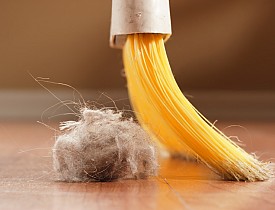How to Reduce Household Allergens
 Sneeze, cough, blow your noise, sneeze, cough, and blow your nose... Does this sound familiar? Is this a seemingly never-ending cycle for you while you are trying to relax in your own home? You are not alone. As many as one in four Americans suffer from indoor allergies.
Sneeze, cough, blow your noise, sneeze, cough, and blow your nose... Does this sound familiar? Is this a seemingly never-ending cycle for you while you are trying to relax in your own home? You are not alone. As many as one in four Americans suffer from indoor allergies.
Dust and mold are the allergens most commonly found inside houses. Fortunately, they can be greatly reduced with a change in your home maintenance routines. It's not such a simple task, because at first as it involves spending a bit of money and taking the time to clean more intensely. The good news is that it really helps and you'll see an instant improvement in the way you feel. You may even notice a monetary benefit as you find yourself spending less on tissues for blowing your nose!
The severity of your allergic symptoms will determine how many steps you'll want to take to reduce the allergens in your home. For some, an increase in dusting, vacuuming, and general cleaning can make a huge improvement. But for most, other steps must be taken as well. Here are practical ways to help reduce household allergens:
Carpets
Carpeting is the #1 household dust collecting problem. Carpets trap dust mites and dust mites love carpets; not a good combination for those allergic to dust mites. Some homeowners remove all carpet and go for linoleum, wood, or ceramic floors. If you'd prefer to stick with carpet, Choose a low-pile, hypo-allergenic type. Vacuum carpets daily with a HEPA-filtered vacuum and clean every few months with a steam cleaner or send them out to a professional service. Dust mites love a damp environment, so run a dehumidifier to keep indoor humidity below 50 percent.
Windows
Windows often trap moisture which quickly turns into mold. Clean mold and condensation from window frames and sills. Replace weather stripping as necessary to help keep the moisture out. Caulk and repair around the window as needed, paying close attention to any cracks. Windows should be kept closed during high pollen times- usually in the early spring through the summer, but this depends on where you live. The best way to reduce household allergens is to not let them in! So keep your windows closed (and the a/c on) and you'll notice an improvement.
Furniture & Window Treatments
Avoid upholstered furniture, especially pieces covered with loosely-woven fabric. Leather, wood, and even plastic furniture is best for reducing household allergens. The best window treatments are washable roller type shades or washable curtains. Keep in mind that curtains collect dust. Washing them frequently, even as often as every few weeks, will help to limit the dust.
Ventilation, Humidification, & Filtration
Furnace and a/c filters should be checked and changed frequently. It's best to use a HEPA air filter which doesn't require monthly replacement. If your HVAC system does not have a whole house ventilation system, consider hiring a contractor to install one. As mentioned previously, keep humidity at no more than 50%, and clean your dehumidifier weekly. Make sure your dryer is properly vented to the outside and have your air ducts cleaned every few years. Using an exhaust fan for the kitchen will reduce fumes and moisture; be sure it is properly vented to the outdoors. A bathroom exhaust fan to reduce moisture while bathing or showering is also important.
Cleaning Habits
Getting rid of clutter significantly cuts down on dust. Keep toys in bins and avoid or limit stuffed animals in your home. Magazines, cardboard boxes, and the like are all magnets for dust and pests. In fact, cockroaches, which happen to be a common allergen, can hide behind boxes. Start a cleaning routine which entails thoroughly dusting the entire house. Other good cleaning habits include emptying garbage daily and using a trash bin with a lid.
Bathroom & Kitchen
Check under all sinks in the bathrooms and kitchens for plumbing leakage; if you find a leak, call a plumber for repair. Use washable bathmats. Remove bathroom wallpaper and replace with tile or mold-resistant enamel paint. Pay close attention to mold growth on the shower curtain and clean it off as necessary. Towel dry the shower or tub after use to limit mold growth. Regularly empty and clean the drip pan of your refrigerator. Clean or replace moldy rubber seals around the fridge doors.
More Tips
- Encase pillows, mattresses, and box springs in dust-proof covers to significantly reduce the amount of dust you breathe. Launder linens once a week in water above 54 degrees Fahrenheit.
- Limit or remove houseplants. Spread aquarium-type gravel over the dirt to contain mold growth.
- Choose a clean-burning natural gas fireplace instead of a wood fireplace, which produces smoke.
Try one, or try all, you'll surely notice a difference either way. These tips for reducing home allergens will also help to improve the general air quality in your home. Even if you do not have allergies, following these suggestions will make for a healthier home.
Updated December 3, 2018.
Looking for a Pro? Call us (866) 441-6648



